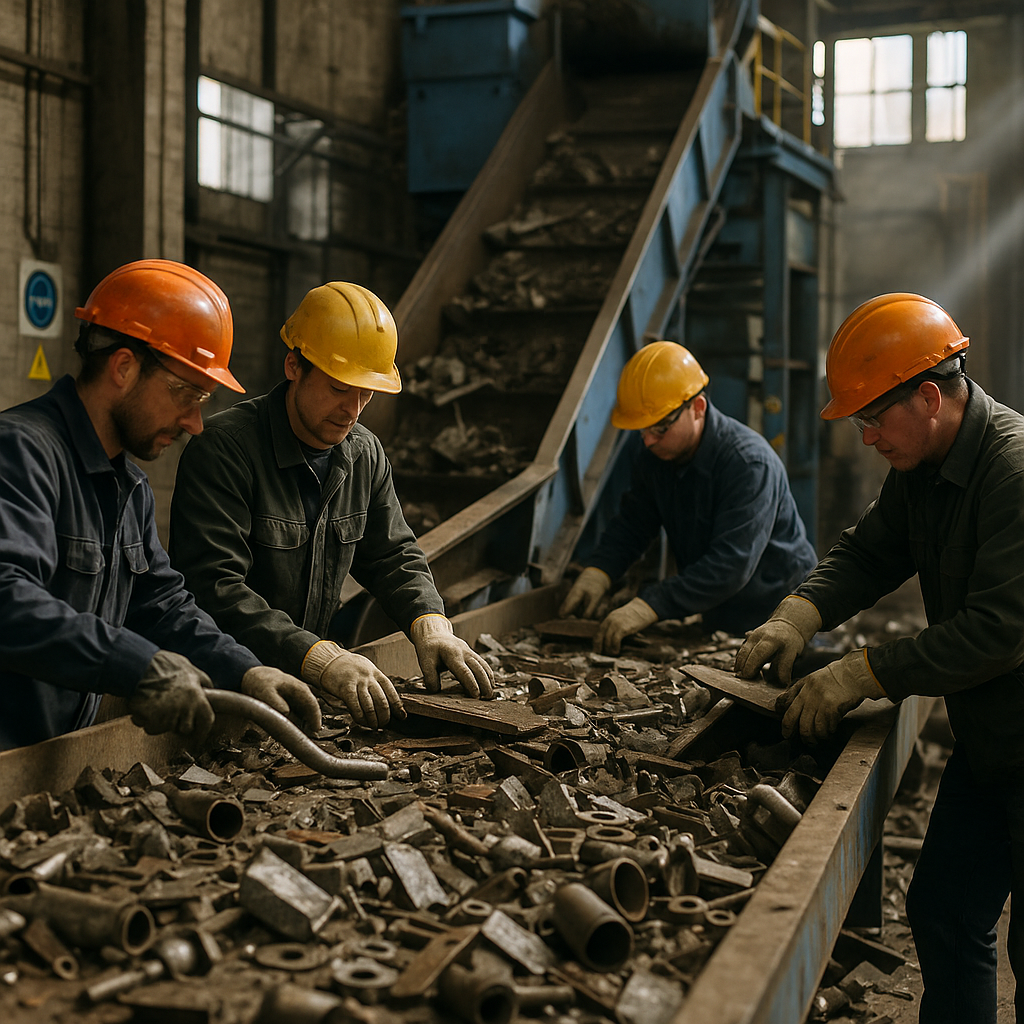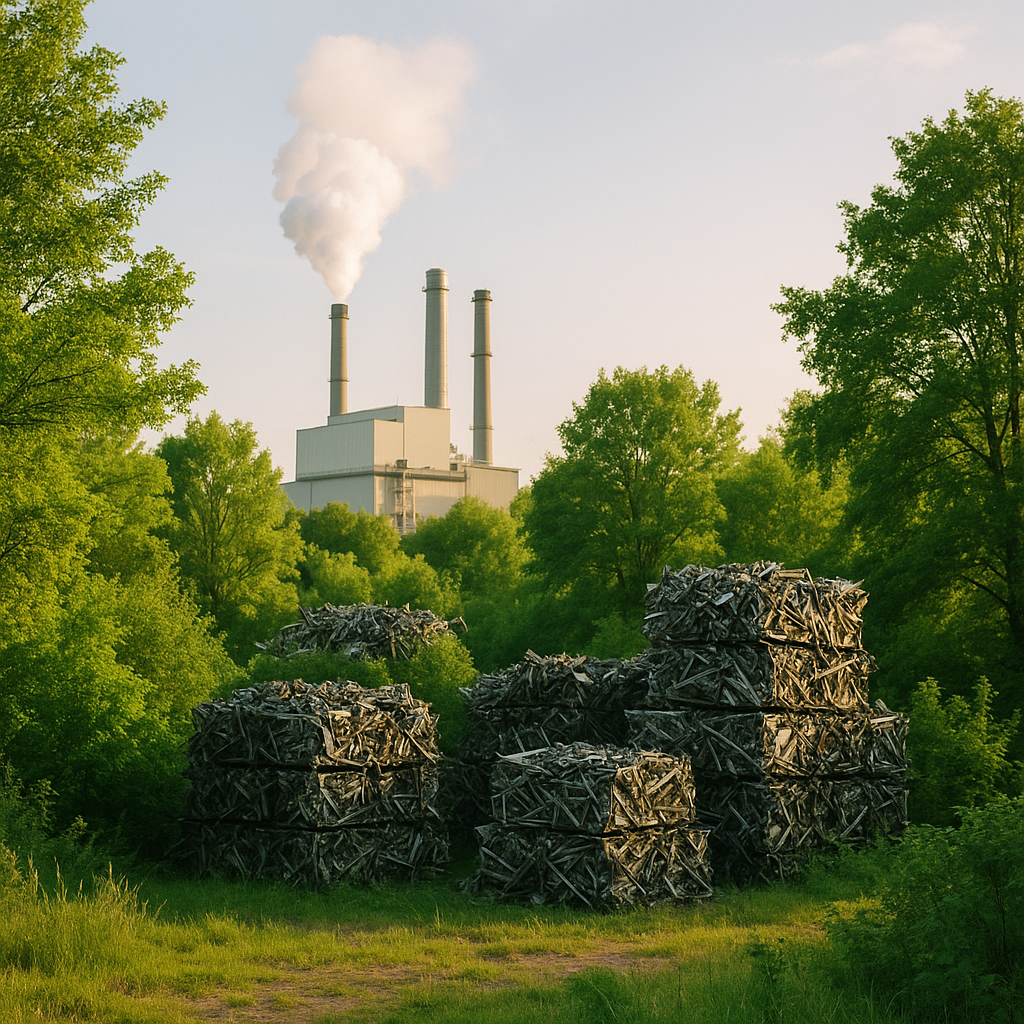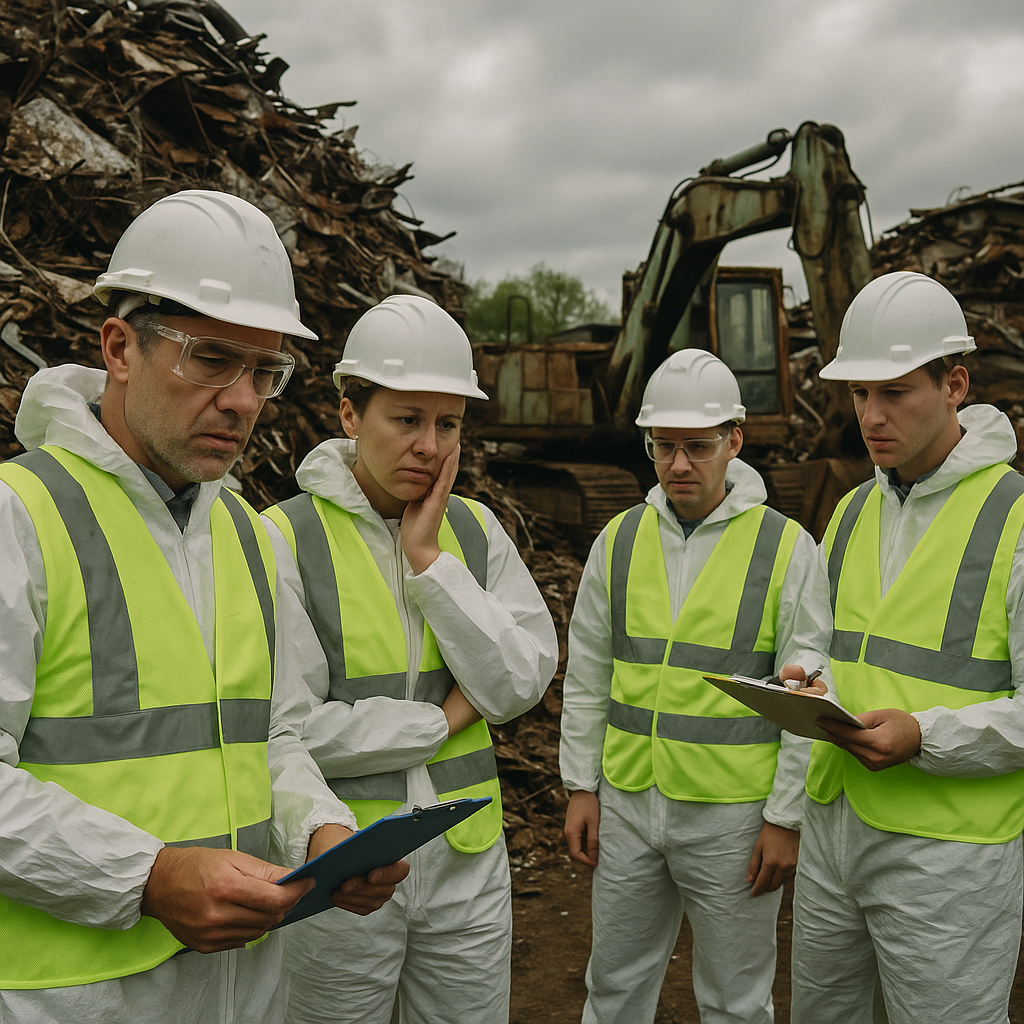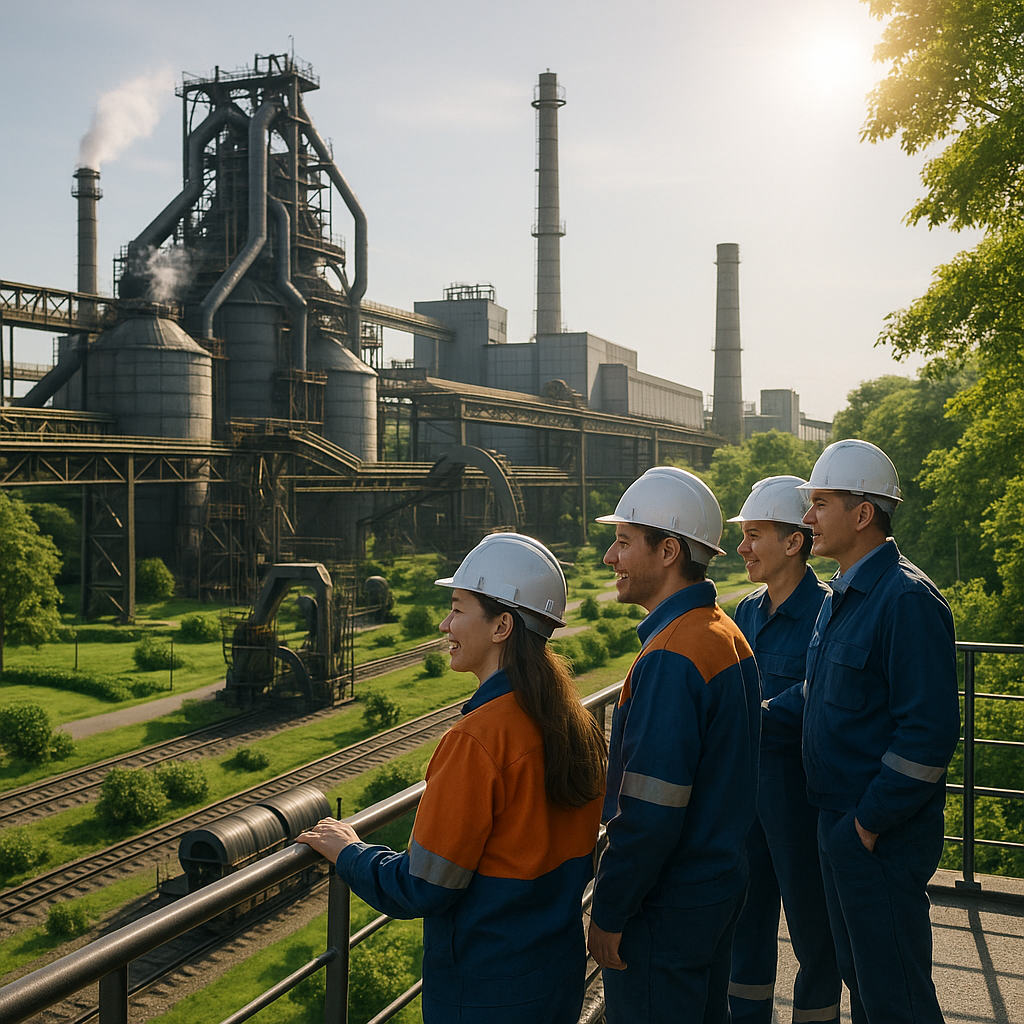5901 Botham Jean Blvd, Dallas, TX 75215
Exploring the Steel Recycling and Why It Is Important for Sustainable Industry
August 23, 2025Did you know that steel has a global recycling rate of 87%? This remarkable figure makes steel one of the most recycled materials on our planet. Its unique properties allow it to be reborn countless times without losing quality or performance.
Steel recycling involves collecting, sorting, and reprocessing scrap steel to create new products. This practice transforms end-of-life items like vehicles, appliances, and construction materials into valuable resources rather than waste. The process typically includes magnetic separation, shredding, cleaning, and melting in electric arc furnaces.
Why is this important for sustainable industry? The answer lies in both environmental and economic benefits. Recycling steel reduces the need to mine virgin iron ore. A single ton of recycled steel conserves about 2,500 pounds of iron ore, 1,400 pounds of coal, and 120 pounds of limestone. This conservation of resources is crucial as we face increasing pressure on our planet’s finite materials.
How Does the Steel Recycling Process Work?

The steel recycling process transforms discarded steel into new products through specialized steps. Unlike traditional blast furnace methods that require raw iron ore and produce significant carbon emissions, steel recycling offers a more sustainable approach to steel production.
Collection and Sorting
The recycling journey begins with collection. Scrap steel comes from sources such as demolished buildings, junked vehicles, old appliances, and industrial waste. At recycling facilities, this mixed material undergoes initial processing where it’s sorted by type and quality.
The sorting phase employs magnetic separation technology—a cornerstone of efficient steel recycling. Powerful magnets generate magnetic fields that attract ferrous (iron-containing) materials while non-magnetic materials continue along the conveyor belt. This automated process speeds up sorting and improves the purity of the recycled materials.
Processing and Preparation
Once sorted, the scrap steel requires preparation before melting. Workers and machines crush and shred the metal into smaller, manageable pieces. During this stage, any remaining non-ferrous materials are removed through additional separation techniques.
The processed scrap also passes through radiation detectors to identify potentially hazardous materials. This multi-stage preparation ensures a clean, high-quality input for the melting process. The processed scrap is then bundled and transported to steel mills for the next phase.
Melting in Electric Arc Furnaces
The heart of modern steel recycling is the electric arc furnace (EAF). Unlike traditional blast furnaces that rely primarily on coal and iron ore, EAFs use electricity to generate intense heat that melts scrap steel efficiently.
In the EAF process, graphite electrodes create an electric arc with temperatures reaching 3,500°C. This extreme heat quickly transforms solid scrap into molten steel. During melting, impurities rise to the surface, forming slag that can be removed and used in other applications like construction materials.
Depending on the desired steel properties, metallurgists may add pure ore or other alloys to achieve specific chemical compositions. This precise control allows for producing various steel grades from recycled materials.
Refining and Forming
After melting, the liquid steel undergoes refining to achieve the required quality and properties. Oxygen may be blown into the furnace to oxidize and remove unwanted elements like carbon, phosphorus, or sulfur. The molten steel is then tapped (poured) into ladles for transport to continuous casting equipment.
In continuous casting, the molten steel solidifies into semi-finished forms like slabs, billets, or blooms. These forms then move to rolling mills where they’re shaped into final products such as sheets, bars, or structural components.
The Circular Economy of Steel
What makes steel recycling particularly valuable is its closed-loop nature. Steel can be recycled infinitely without degrading its quality or strength. This property creates a truly circular system that minimizes waste and conserves resources.
The environmental benefits are substantial. Recycling steel through EAFs produces approximately 0.67 tonnes of CO2 per ton of steel—about 71% less than traditional blast furnace methods. Additionally, using scrap steel reduces energy consumption by up to 60% compared to making steel from raw materials.
Magnetic separation technology plays a crucial role in making this circular system efficient. By quickly extracting steel from mixed waste streams, these separators ensure that valuable materials don’t end up in landfills and remain available for continuous recycling.
The steel recycling process represents modern industrial sustainability in action. From collection and magnetic separation to melting in electric arc furnaces and reforming into new products, each step contributes to a system that conserves resources while meeting global demand for this essential material.
What Are the Environmental Benefits of Steel Recycling?

Steel recycling is one of the most effective environmental practices in modern waste management. By reusing steel scrap, energy consumption is reduced by 75% compared to producing new steel from raw materials. This conservation leads to significant CO2 emission reductions across the global steel industry.
The process greatly decreases greenhouse gas emissions. The steel industry’s recycling efforts prevent approximately 950 million tons of CO2 emissions annually, equivalent to removing over 200 million cars from roads worldwide. Each ton of recycled steel conserves 2,500 pounds of iron ore, 1,400 pounds of coal, and 120 pounds of limestone.
Water conservation is another key benefit of steel recycling. Traditional steelmaking requires substantial water resources, but recycling saves up to 40% of the water typically used in production. This conservation is especially valuable as fresh water becomes increasingly precious worldwide.
Reducing mining activities presents further environmental advantages. Recycling decreases the demand for virgin materials like iron ore and coal, helping preserve natural landscapes and preventing habitat destruction. Mining often results in soil erosion, water contamination, and biodiversity loss. By recycling steel, we directly mitigate these impacts.
Waste reduction is another compelling benefit. Steel is 100% recyclable and can be reused indefinitely without losing strength or quality. This makes it ideal for a circular economy where waste is minimized. By diverting steel scrap from landfills, recycling extends the lifespan of waste disposal facilities and reduces the environmental burden of waste management.
The benefits extend beyond physical resources. The steel recycling industry creates jobs and economic opportunities. In the United States, the ferrous scrap processing sector is valued at billions of dollars annually and supports over half a million jobs, illustrating how environmental stewardship and economic growth can work together.
Steel recycling stands out for its efficiency across various materials. While all recycling is beneficial, steel’s magnetic properties make it easy to separate from other waste. This efficiency increases recovery rates and ensures more steel returns to production instead of ending up in landfills.
Even small-scale recycling efforts yield significant results. Recycling a single refrigerator reduces greenhouse gas emissions by 215 pounds of CO2. Recycling one steel food can saves enough energy to power a 10-watt LED bulb for over 24 hours. When multiplied across billions of steel cans recycled yearly, these savings become substantial.
How Does Steel Recycling Support Economic Sustainability?

Steel recycling provides significant economic benefits in addition to its environmental advantages. The industry generates employment opportunities at every step of the recycling process, from collection specialists who gather discarded steel to technicians using advanced sorting technology. The job creation impact spans the entire value chain.
In the United States alone, the steel recycling industry supports over 500,000 jobs across various sectors, including collection, processing, manufacturing, and distribution. Workers in this field develop expertise in material identification, processing technology, and quality control.
The American Iron and Steel Institute reports that the recycling process contributes over $110 billion in economic activity annually. This substantial input strengthens local economies and provides tax revenue for communities, creating job opportunities in both urban and rural areas for a range of education and skill levels.
Price Stabilization and Cost Reduction
Steel recycling considerably lowers manufacturing costs compared to producing steel from raw materials. Using recycled steel requires about 75% less energy than extracting and processing virgin ore, resulting in lower production costs and more competitive pricing for steel products.
The recycling market also helps stabilize steel prices by reducing reliance on raw material extraction. When manufacturers have access to reliable sources of recycled steel, they are less vulnerable to price fluctuations in the mining sector. This stability benefits downstream industries such as construction, automotive manufacturing, and appliance production.
Steel’s unique properties allow it to be recycled indefinitely without quality loss, creating a sustainable cycle where materials remain in productive use rather than becoming waste. The economic value of steel scrap incentivizes proper disposal and collection, further supporting the recycling infrastructure.
| Impact Category | Details |
|---|---|
| Recycling Rate | 69% of steel is recycled in the U.S. annually |
| Energy Savings | 75% of the overall energy used in steel production is saved via recycling |
| Job Creation | Over 531,000 jobs are created in the U.S. scrap recycling industry |
| Economic Activity | Steel recycling results in over $110 billion in economic activity annually |
Economic and Environmental Alignment
Steel recycling exemplifies how environmental and economic sustainability can align effectively. The same processes that reduce carbon emissions and conserve natural resources also generate jobs and economic growth. This dual benefit makes steel recycling a model for sustainable industrial practices.
Businesses incorporating recycled steel into their supply chains often achieve cost savings while fulfilling sustainability goals. For instance, construction companies can reduce material costs while promoting their projects as environmentally responsible, adding further economic incentives for recycling.
The economic advantages extend beyond the recycling facilities themselves. Transportation companies, equipment manufacturers, and technology developers all support and benefit from the recycling infrastructure, creating a network of interconnected businesses that collectively enhance economic sustainability.
What Challenges Does Steel Recycling Face?

Steel recycling offers significant environmental and economic benefits, but the industry faces several challenges impacting its efficiency and sustainability. From quality control to market volatility, these obstacles require innovative solutions to ensure the growth of steel recycling.
Scrap Quality Control Issues
A persistent challenge in steel recycling is maintaining consistent scrap quality. Contamination from non-metallic materials, chemicals, and other impurities can reduce the value and usability of recycled steel. When scrap contains excessive copper, tin, or zinc, the resulting steel may have compromised structural integrity or surface quality.
Advanced sorting technologies are helping to address this challenge. Recycling facilities now employ systems that combine magnetic separation, optical sorting, and artificial intelligence to identify and remove contaminants, ensuring recycled steel meets the stringent quality standards required by manufacturers.
Market Price Fluctuations
The steel recycling industry operates within unpredictable market dynamics. Scrap metal prices can vary greatly due to global economic conditions and changes in manufacturing demand. These fluctuations create financial uncertainty for recyclers and can disrupt the entire supply chain.
According to industry data, revenue in the scrap metal recycling industry has experienced a compound annual growth rate decline of 2.1% over a recent five-year period, highlighting the challenging market conditions. Volatility is particularly problematic for smaller recycling operations with limited financial reserves to weather market downturns.
Strategic hedging and diversification of revenue streams are increasingly important for recyclers to maintain financial stability during market swings. Some companies are forming long-term supply agreements with steel mills to provide more predictable pricing structures.
Energy Consumption Challenges
While recycling steel requires less energy than producing virgin steel from iron ore, the process still consumes substantial energy. Melting scrap steel in electric arc furnaces requires high temperatures and considerable electricity. The industry continues to seek more energy-efficient technologies to reduce operational costs and environmental impact.
Innovative approaches include waste heat recovery systems that capture and reuse thermal energy from the recycling process, reducing overall energy requirements. Some recycling facilities are also incorporating renewable energy sources like solar or wind power to decrease their carbon footprint.
Complex Regulatory Requirements
Steel recyclers must navigate a complex web of environmental regulations and compliance requirements that vary across regions and countries, creating challenges for companies operating in multiple jurisdictions. Regulations cover everything from air emissions and water discharge to waste management and transportation.
Staying current with changing regulations requires substantial resources and expertise. Forward-thinking recycling companies are investing in environmental management systems and specialized staff to ensure compliance and identify opportunities to exceed regulatory standards as a competitive advantage.
Transportation and Logistics Hurdles
The physical movement of steel scrap presents logistical challenges. Scrap metal is heavy and bulky, making transportation costly and energy-intensive. Rising fuel costs and driver shortages have further complicated logistics for recyclers.
To address these challenges, some recyclers are optimizing transportation routes and increasing load efficiency. Others are exploring alternative methods, such as rail or water shipping, which can be more cost-effective and environmentally friendly for long-distance transport.
| Challenge | Description | Potential Solutions |
|---|---|---|
| Scrap Quality Control | Contamination from non-metallic materials and impurities | Advanced sorting technologies like AI, optical sorting, and magnetic separation |
| Market Price Fluctuations | Unpredictable scrap metal prices due to economic and demand changes | Strategic hedging, diversification, long-term supply agreements |
| Energy Consumption | High energy usage in melting processes | Waste heat recovery, renewable energy sources, more efficient technologies |
| Regulatory Requirements | Navigating complex environmental regulations | Invest in environmental management systems and skilled staff |
| Transportation and Logistics | Costly and challenging transport of heavy scrap metal | Optimize routes, increase load efficiency, explore alternative transport methods |
Conclusion: The Future of Steel Recycling in Sustainable Industry

Steel recycling is a cornerstone of sustainable industry, offering significant environmental, economic, and social benefits. The process reduces energy consumption by up to 60% compared to traditional production methods. This efficiency results in lower carbon emissions, with recycled steel production emitting about 0.4 tons of CO2 per ton of steel, compared to 1.4 tons in primary production.
With ongoing technological advancements, the steel recycling industry is set for transformation. Innovations in sorting technologies, leveraging AI and machine learning, are expected to enhance efficiency. Additionally, energy-efficient melting techniques will further minimize environmental impact. These developments will solidify steel’s role in the circular economy, ensuring materials remain in use for extended periods.
For professional guidance on steel recycling solutions that can benefit your organization or municipality, contact Okon Recycling at 214-717-4083. Our team can assist in implementing effective recycling strategies for a more sustainable future.
